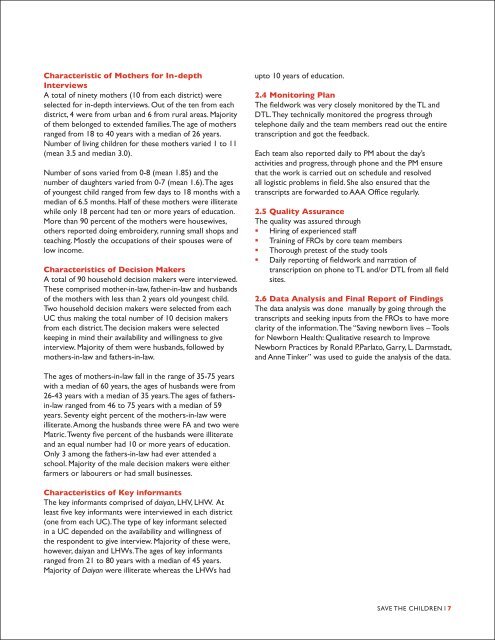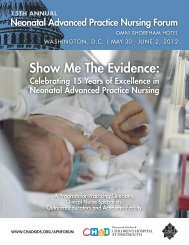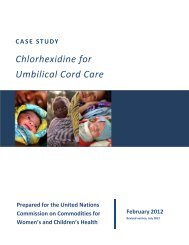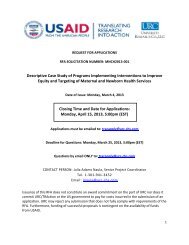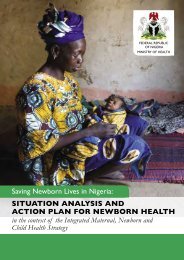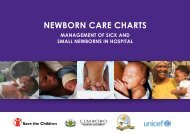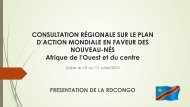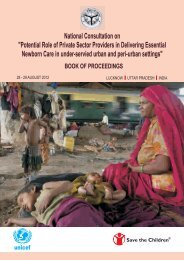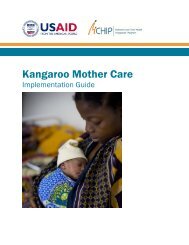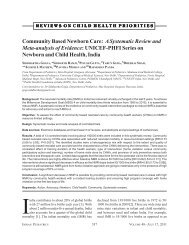Download Resource - Healthy Newborn Network
Download Resource - Healthy Newborn Network
Download Resource - Healthy Newborn Network
Create successful ePaper yourself
Turn your PDF publications into a flip-book with our unique Google optimized e-Paper software.
Characteristic of Mothers for In-depth<br />
Interviews<br />
A total of ninety mothers (10 from each district) were<br />
selected for in-depth interviews. Out of the ten from each<br />
district, 4 were from urban and 6 from rural areas. Majority<br />
of them belonged to extended families. The age of mothers<br />
ranged from 18 to 40 years with a median of 26 years.<br />
Number of living children for these mothers varied 1 to 11<br />
(mean 3.5 and median 3.0).<br />
Number of sons varied from 0-8 (mean 1.85) and the<br />
number of daughters varied from 0-7 (mean 1.6). The ages<br />
of youngest child ranged from few days to 18 months with a<br />
median of 6.5 months. Half of these mothers were illiterate<br />
while only 18 percent had ten or more years of education.<br />
More than 90 percent of the mothers were housewives,<br />
others reported doing embroidery, running small shops and<br />
teaching. Mostly the occupations of their spouses were of<br />
low income.<br />
Characteristics of Decision Makers<br />
A total of 90 household decision makers were interviewed.<br />
These comprised mother-in-law, father-in-law and husbands<br />
of the mothers with less than 2 years old youngest child.<br />
Two household decision makers were selected from each<br />
UC thus making the total number of 10 decision makers<br />
from each district. The decision makers were selected<br />
keeping in mind their availability and willingness to give<br />
interview. Majority of them were husbands, followed by<br />
mothers-in-law and fathers-in-law.<br />
upto 10 years of education.<br />
2.4 Monitoring Plan<br />
The fieldwork was very closely monitored by the TL and<br />
DTL. They technically monitored the progress through<br />
telephone daily and the team members read out the entire<br />
transcription and got the feedback.<br />
Each team also reported daily to PM about the day’s<br />
activities and progress, through phone and the PM ensure<br />
that the work is carried out on schedule and resolved<br />
all logistic problems in field. She also ensured that the<br />
transcripts are forwarded to AAA Office regularly.<br />
2.5 Quality Assurance<br />
The quality was assured through<br />
• Hiring of experienced staff<br />
• Training of FROs by core team members<br />
• Thorough pretest of the study tools<br />
• Daily reporting of fieldwork and narration of<br />
transcription on phone to TL and/or DTL from all field<br />
sites.<br />
2.6 Data Analysis and Final Report of Findings<br />
The data analysis was done manually by going through the<br />
transcripts and seeking inputs from the FROs to have more<br />
clarity of the information. The “Saving newborn lives – Tools<br />
for <strong>Newborn</strong> Health: Qualitative research to Improve<br />
<strong>Newborn</strong> Practices by Ronald P.Parlato, Garry, L. Darmstadt,<br />
and Anne Tinker” was used to guide the analysis of the data.<br />
The ages of mothers-in-law fall in the range of 35-75 years<br />
with a median of 60 years, the ages of husbands were from<br />
26-43 years with a median of 35 years. The ages of fathersin-law<br />
ranged from 46 to 75 years with a median of 59<br />
years. Seventy eight percent of the mothers-in-law were<br />
illiterate. Among the husbands three were FA and two were<br />
Matric. Twenty five percent of the husbands were illiterate<br />
and an equal number had 10 or more years of education.<br />
Only 3 among the fathers-in-law had ever attended a<br />
school. Majority of the male decision makers were either<br />
farmers or labourers or had small businesses.<br />
Characteristics of Key informants<br />
The key informants comprised of daiyan, LHV, LHW. At<br />
least five key informants were interviewed in each district<br />
(one from each UC). The type of key informant selected<br />
in a UC depended on the availability and willingness of<br />
the respondent to give interview. Majority of these were,<br />
however, daiyan and LHWs. The ages of key informants<br />
ranged from 21 to 80 years with a median of 45 years.<br />
Majority of Daiyan were illiterate whereas the LHWs had<br />
SAVE THE CHILDREN l 7


